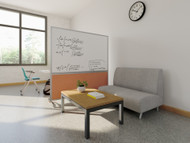5 Layout Ideas to Balance Collaboration and Focus in Academic Spaces
Posted by Kate Murphy on Aug 21st 2025
Gone are the days when university libraries were all shushing and solitary study carrels. Now they’re part think tank, part quiet retreat—buzzing with group brainstorms in one corner and laser-focused study sessions in another.
For library directors, the trick is playing matchmaker between two main personalities: the social collaborator and the quiet concentrator. Both deserve their space, and neither should step on the other’s toes. The answer? Flexible layouts that evolve with the ebb and flow of the academic calendar.
Below, explore five practical layout strategies—featuring Versare room dividers and other smart solutions—that make it easier to give every student the environment they need to thrive.
Recognizing the Needs of Modern Academic Spaces
It’s a fact: Students today expect more from their academic spaces than ever before. They want library spaces that are easy to access and offer a variety of zones for quiet study, group work, and social interaction. Above all, these spaces need to be comfortable and welcoming, supporting both individual academic concentration and collaborative energy.
Today’s library spaces aren’t just about books and quiet corners—they’re social, collaborative, and tech-enabled hubs. Three major trends shape how these areas should be designed:
- Dual demand: Students want access to both silent, distraction-free study areas and active, collaborative zones.
- Shifting learning styles: Team projects, blended learning, and interdisciplinary work require adaptable, multiuse environments.
- Technology integration: Screens, video conferencing, and shared digital tools are now core parts of academic work—and they change how space is used.
Creating a space that meets these diverse needs doesn’t require expensive renovations. With the right modular tools and furniture, you can reconfigure your layout quickly and cost-effectively to create a truly collaborative academic space.
Idea 1: Zoning with Movable Partitions and Room Dividers
One of the easiest ways to balance focus and collaboration is by zoning your school space into clear areas for different focus types. Instead of investing in permanent walls, portable school dividers let you create quiet reading corners, secluded study tables, or group spaces that can change with the day’s needs.
For example, during exam season, roll out extra dividers to block off silent zones for concentrated study. For events or workshops, open the space by quickly moving them aside. At peak times, reconfigure them to create temporary overflow areas for study groups, keeping noise in check while giving everyone a place to work.
Because they’re mobile, these partitions can be rearranged in minutes, keeping your library responsive to the demands of campus life—supporting both the whisperers and the brainstormers without missing a beat.
Idea 2: Incorporating Acoustically-Treated Collaborative Pods
In an open library layout, group work doesn’t have to turn into background noise for everyone else. Acoustically-treated pods—essentially semi-enclosed meeting spaces lined with sound-absorbing materials—can contain conversations so they stay in the pod, not in the surrounding study zones. This lets students brainstorm, debate, or rehearse presentations without derailing the focus of those nearby.
Beyond noise control, pods can be outfitted with tools that make group work seamless: rolling whiteboards for mapping ideas, large monitors for reviewing research, and charging ports for powering multiple devices at once. Whether used for team assignments, tutoring sessions, or quick project check-ins, they create a self-contained hub where collaboration thrives—and quiet zones stay quiet.
To take the sound control up a notch, integrate sound-dampening panels, like wall-mounted, freestanding, or ceiling versions, as an extra layer of quiet around the room. These acoustic panels absorb and diffuse noise, keeping the volume down while maintaining a comfortable, natural sound.
Idea 3: Flexible Furniture for Quick Space Reconfiguration
A library layout that works during finals week might not be ideal during the start of the semester. That’s where modular, mobile furniture comes in.
Imagine rolling tables and desks that glide effortlessly across floors, allowing you to quickly expand collaborative seating as group assignments ramp up. Stackable chairs can be brought out or tucked away depending on how many students are in the space, while movable whiteboard walls create instant brainstorming stations wherever they’re needed.
When it’s time to switch gears, these elements let you transform open school areas into peaceful, focus spaces in a matter of minutes. The same furniture can be rearranged to accommodate special events, guest lectures, or workshops without the hassle or expense of permanent construction.
This flexible furniture approach not only saves money compared to costly renovations but also ensures your library layout can evolve alongside the ever-changing rhythms of academic life.
Idea 4: Strategic Placement of Technology Zones
Technology is essential in modern academic work—but it can also be a major source of noise. The solution is centralizing tech zones so they’re accessible yet contained.
Designate specific zones equipped with monitors for group video calls, ample outlets for charging multiple devices, and digital whiteboards or touchscreen displays for interactive sessions. Surround these tech-heavy areas with room dividers or acoustic panels to absorb sound and minimize noise spillover.
By clustering tech resources together, you make it easy for groups to work while keeping quiet study sections truly peaceful.
Idea 5: Layered Privacy for Study Desks
Not every student needs a closed-off study room—sometimes a little privacy is enough to boost focus. Desk dividers can provide that buffer without isolating users completely.
Privacy screens take this concept further with a layered approach. These screens not only shield sightlines but also incorporate sound-dampening materials to reduce chatter and background noise. The result is a personal sanctuary at each desk that encourages concentration without cutting off interaction entirely. Because these panels are portable and easy to reposition, library staff can quickly adjust layouts based on demand, creating more private spots during peak study times or opening things up when flexibility is needed
How To Put These Layout Ideas Into Action
If you want to ace your library layout, start by learning how students move through and use different zones—then tailor spaces that support both quiet concentration and group work. A thoughtful balance of privacy and openness makes the library welcoming for all.
Assess how students use different areas throughout the day and across the semester to understand patterns and needs. From there, identify priority zones—deciding which spaces should be dedicated to quiet study, which are best suited for group collaboration, and which can remain flexible for changing demands.
Before committing to a full redesign, pilot your ideas by testing a small section of the library with movable partitions or new furniture. This hands-on trial lets you see what works in practice and gather real feedback. Use surveys and observe usage to ensure the changes truly meet student needs.
Above all, stay adaptable. Academic spaces flourish when layouts can shift with evolving demands, so keep your furniture and partitions mobile and versatile.
By following these steps, you can create a library environment that supports both focused study and lively teamwork—without the expense or hassle of permanent construction.
To explore the full range of Versare room dividers, acoustic panels, privacy screens, and more, visit Versare.com or get in touch for personalized recommendations.


